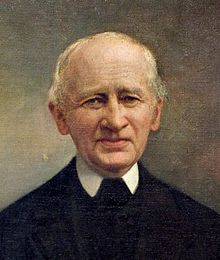Johann Gottfried Galle
This articleneeds additional citations forverification.(September 2012) |
Johann Gottfried Galle | |
|---|---|
 | |
| Born | 9 June 1812 |
| Died | 10 July 1910(aged 98) |
| Alma mater | University of Berlin |
| Known for | Discovery of Neptune |
| Awards | Lalande Prize(1839) |
| Scientific career | |
| Fields | Astronomy |
| Institutions | Berlin Observatory University of Breslau |
| Signature | |


Johann Gottfried Galle(9 June 1812 – 10 July 1910) was a Germanastronomerfrom Radis, Germany, at theBerlin Observatorywho, on 23 September 1846, with the assistance of studentHeinrich Louis d'Arrest,was thefirst person to view the planet Neptuneand know what he was looking at.Urbain Le Verrierhad predicted the existence and position of Neptune, and sent the coordinates to Galle, asking him to verify.[1]Galle found Neptune in the same night he received Le Verrier's letter, within 1° of the predicted position. The discovery of Neptune is widely regarded as a dramatic validation ofcelestial mechanics,and is one of the most remarkable moments of 19th-century science.
Early life
[edit]Galle was born in thePapsthaus(a house in the Pabst wood) 2 km west ofRadisin the vicinity of the town ofGräfenhainichen,as the first son of Marie Henriettenée Pannier(1790–1839) and Johann Gottfried Galle (1790–1853),[2]an operator of a tar oven. He attended the Gymnasium inWittenbergand studied atFriedrich-Wilhelms-Universität Berlinfrom 1830 to 1833. He became a teacher at the Gymnasium inGuben,teaching mathematics andphysics.Later on, he transferred to the Gymnasium in Berlin.
Berlin Observatory
[edit]He had started to work as an assistant toJohann Franz Enckein 1835 immediately following the completion of the new Berlin Observatory. Galle worked there for the next 16 years, making use especially of aFraunhofer-refractorwith 9Zoll(~22.5 cm)aperture.In 1838 he discovered an inner, dark ring ofSaturn.From 2 December 1839 to 6 March 1840 he discovered three newcomets.
In 1845 Galle was awarded aDr. phil.Hisdoctoral thesiswas a reduction and critical discussion ofOle Rømer's observation ofmeridiantransits ofstarsandplanetson the days from 20 October to 23 October 1706.
Discovery of Neptune
[edit]
Around the same time in 1845 he sent a copy of his thesis toUrbain Le Verrier,but only received an answer a year later. Sent on 18 September 1846, it reached Galle on the morning of 23 September. Le Verrier had been investigating theperturbations of the orbitof the planetUranusand from this he derived the position of a still undiscovered planet, and requested Galle to search in the corresponding section of sky. The very same night (after Encke gave permission to search, against his own judgement), in collaboration with his assistantHeinrich Louis d'Arrest,Galle discovered a star of 8thmagnitude,only 1° away from the calculated position, which was not recorded in theBerliner Akademischen Sternkarte.Over the next two evenings, aproper motionof the celestial object of 4seconds of arcwas measured, which determined it absolutely as a planet, for which Le Verrier proposed the nameNeptune.Galle always refused to be acknowledged as the discoverer of Neptune; he attributed the discovery to Le Verrier.
In 1847 Galle was designated as the successor toFriedrich Wilhelm Besselas Director ofKönigsberg Observatory.Before the enacted nomination fromFriedrich Wilhelm IVeffectedde facto,Galle withdrew his application at the beginning of 1848 due to an intrigue against him led byCarl Gustav Jacob Jacobi.[3]
Breslau Observatory
[edit]In 1851 he moved toBreslau(todayWrocław) to become the director of the local observatory, and in 1856 he became Professor of Astronomy at theSchlesischen Friedrich-Wilhelms-Universität Breslau.He worked in Breslau for over 45 years. For the academic year 1875/76 he was electedRector.[4]At Breslau he dealt with the exact determination of planetaryorbitsand developed methods for calculating the height of theauroraeand the path ofmeteors,and consolidated the data for all 414 comets discovered up to 1894 into one work (with the help of his son). Otherwise he concerned himself with theEarth's magnetic fieldandclimatology.Altogether he published over 200 works.
Later years
[edit]In 1897 Galle returned toPotsdam,where he died in 1910 at the age of 98. He was survived by his wife and two sons, Andreas Galle and Georg Galle (1860–1946).
The town ofGräfenhainichen,which is close to his birthplace, erected a memorial to him in 1977.
Twocraters,oneon the Moonand the "happy face" oneon Mars,the asteroid2097 Galle,and aring of Neptunehave been named in his honor.
In Breslau (today Wrocław) itself, it was commemorated by naming one of the streets with his last name –Gallestrasse.This name was in force until the end of World War II. Its contemporary name is Wapienna (meaningLimestonein Polish) Street.[5][6]
Legacy
[edit]Googlecelebrated Galle's 200th birthday with aGoogle Doodle.[7]
References
[edit]- ^"Urbain-Jean-Joseph Le Verrier".Encyclopædia Britannica.March 7, 2021.RetrievedJune 27,2021.
- ^Hockey, Thomas (2009).The Biographical Encyclopedia of Astronomers.Springer Publishing.ISBN978-0-387-31022-0.RetrievedAugust 22,2012.
- ^Diedrich Wattenberg:Nach Bessels Tod – Eine Sammlung von Dokumenten.Veröffentlichungen der Archenhold-Sternwarte Berlin-Treptow Nr. 7. 1976
- ^Rektoratsreden (HKM)
- ^Małgorzata Kubiak-Wolf."Glinianki, Huby i okolice. Historia naszych ulic"(in Polish). p. 19.RetrievedSeptember 23,2021.
- ^"Niemiecko-polski słownik nazw ulic"(PDF).Wratislavia.net(in Polish). 2012. p. 50 (Gallestr.).RetrievedSeptember 23,2021.
- ^"Johann Gottfried Galle's 200th Birthday".
External links
[edit]Obituaries
[edit]- Franz, J. (1910)."Anzeige des Todes von Johann Gottfried Galle".Astronomische Nachrichten(in German).185(19): 309.Bibcode:1910AN....185..309F.doi:10.1002/asna.19101851906.
- Chant, C.A. (1910). "Johann Gottfried Galle".Journal of the Royal Astronomical Society of Canada.4:379.Bibcode:1910JRASC...4..379C.
- "Obituary Notices: Associates: Galle, Johann Gottfried".Monthly Notices of the Royal Astronomical Society.71:275. 1911.Bibcode:1911MNRAS..71R.275..doi:10.1093/mnras/71.4.272.
- "Obituaries: G.V. Schiaparelli, J.G. Galle, J.B.N. Hennessey J. Coles, J.E. Gore".The Observatory.33:311. 1910.Bibcode:1910Obs....33..311.

